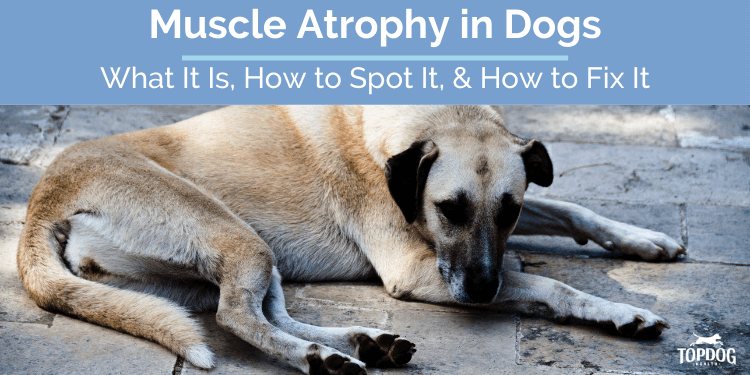
From this we can suspect that loss of muscle mass may be correlated with loss of muscle strength. The only way to be sure your pet has CHD is by consulting with a veterinarian.

Muscle atrophy in dogs is the wasting or loss of the dogs muscle tissue.
Dog losing muscle mass hips. If your dog is losing muscle mass it will usually result in weight loss. If your dog is starting to look thinner or feels lighter than normal when you pick him up it would be a good idea to start weekly weigh-ins. If you notice your dog is continuously losing weight this is likely a sign of muscle atrophy.
The symptoms of CHD are lameness limping reluctance to rise or jump shifting of weight to the forelimbs loss of muscle mass on the rear limbs and hip pain. Generally divide dogs with CHD into two groups showing symptoms of CHD. Younger dogs without arthritis but with significant hip laxity.
More mature dogs that have. Atrophy Loss of Muscle Mass in Dog Legs. Loss of muscle mass in thigh muscles Enlargement of shoulder muscles due to more weight being exerted on front legs as dog tries to avoid weight on its hips leading to extra work for the shoulder muscles and subsequent enlargement of these muscles.
The wrong diet could be worsening your dogs muscle atrophy. Foods high in carbohydrates are a big no-no if your dog is losing muscle. Too many carbs can put weight on your dog alright.
But its not the kind of weight gain youll want to see. An overweight dog with a high body fat percentage is susceptible to other health issues. Muscular atrophy is a weakening or wasting away of muscle mass.
It can be observed as a loss of muscle tone and is most obvious on the hind legs and hips of senior dogs. Muscular atrophy has two main causes. Lack of activity and disease the two frequently working hand in hand.
What Is Muscle Atrophy. Muscle atrophy in dogs is the wasting or loss of the dogs muscle tissue. It often occurs in the legs particularly the hind legs although it can show up in other areas of the body.
When atrophy results from an injury or surgery it may be fairly obvious. But thats not always the case. Typically this will be an injury of some kind which makes movement uncomfortable which will eventually result in progressive muscle atrophy in the dog.
Another common ailment. This is likely because it would be hard to actually quantify. However loss of muscle mass is reported commonly in dogs with hip dysplasia and we assume this is due to disuse.
From this we can suspect that loss of muscle mass may be correlated with loss of muscle strength. Daily exercise helps maintain fitness and endurance. A loss of muscle mass is usually because the dog is not using this leg as much as the other.
The cause of that is usually because of pain. There are a number of things that could be causing this pain. If this is a hind leg hip dysplasia which is severe arthritis in the hip could be a cause.
In severe cases loss of muscle mass may occur in affected areas. Symptoms primarily affect the hip area and hind legs. CHD Diagnosis Treatment for Your Aussie.
The only way to be sure your pet has CHD is by consulting with a veterinarian. In a classic case you may also see a number of accompanying signs including a bunny-hopping gait in the rear limbs a dog shifting a large proportion of his weight to his front legs wasting of the muscle mass in the thigh area stiffness and soreness when the dog gets up after resting and a reluctance to jump up to either jump up on his. Mobility problems are especially common as dogs grow older whether caused by arthritis fatigue or a more serious problem like hip dysplasia.
But another less-discussed problem that can impact not only mobility but overall wellness is muscular atrophy. Just like in humans dogs tend to lose muscle mass as they age. The physical changes in your dogs body caused by muscle atrophy are easy to spot.
As dogs become less active their muscles begin to atrophy. Dogs that are ill dealing with joint pain or struggle to walk will lose muscle mass at a faster pace than other dogs. Most dogs will show signs of atrophy in their hips and hind legs first which may make their hind end look.
Degenerative myelopathy is a condition in which a dogs spinal cord degenerates over time. In addition to muscle loss symptoms include swaying in the hindquarters when standing easily falling over when pushed from the side difficulty getting up and dragging the hind feet when walkingAs the disease progresses dogs may become paralyzed and lose bladder and bowel. Muscle atrophy or muscle loss is the wasting away of your dogs muscles.
It can present in a number of ways and can be caused by ageing illness or simply by reduced activity. Larger breeds can be more likely to suffer as they can age faster than small breeds and are more prone to conditions like arthritis but muscle atrophy can affect any dog. Of course such muscle mass loss could also be related to your pets diet specifically poor-quality diets or them just not taking in enough calories.
But if your pet is on a good quality diet and they are eating then its far more likely that their weight and muscle mass loss is due to one of the conditions in the list provided above. Polymyositis is an inflammatory muscle disorder in adult dogs that affects the entire body. It may be associated with immune-mediated disorders such as lupus erythematosus or myasthenia gravis.
The condition can have a sudden onset or it may be recurring and progressive. Signs include depression lack of energy weakness weight loss.